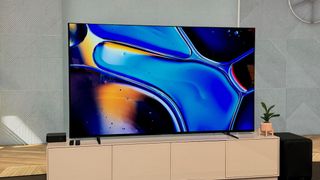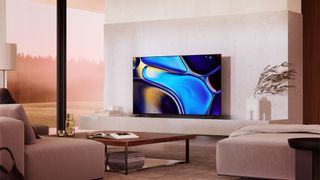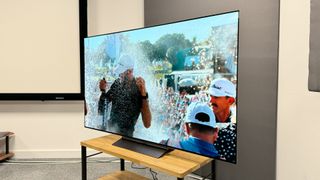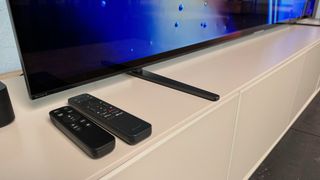LG’s C-series models have long been the best step-down OLED TVs you can buy, until they weren’t. Last year, a lack of significant improvements plus an on-form Sony led the Japanese giant’s A80L to win Product of the Year at the What Hi-Fi? Awards. LG must have been fuming.
Now it’s looking to win back its crown with the C4. On paper, it’s again not a huge improvement on the previous model, but in practice it blew us away, earning the full five stars.
But Sony hasn’t stood still either. Its Bravia 8 replaces the A80L, with a refined design, brighter image, new processor and better sound. It’s going to be quite a fight…
Sony Bravia 8 vs LG C4: price
We’ve seen prices rise on all kinds of devices over the last couple of years, so we welcome the C4’s price with open arms. In the UK, it’s launched slightly cheaper than the C3 before it (which was pricier than the previous year’s C2). That’s also true in Australia – at most sizes, at least – but in the US it’s $99 more expensive across the board.
Here’s a price breakdown.
- 42in: £1400 / $1499 / AU$2199
- 48in: £1500 / $1599 / AU$2499
- 55in: £1900 / $1999 / AU$3299
- 65in: £2700 / $2699 / AU$4299
- 77in: £3800 / $3699 / AU$5999
- 83in: £6000 / $5399 / AU$7999
Remember: these are only the launch prices. As is the case with most devices, they will come down over the year. LG’s TVs tend to feature heavily in the usual sales (Prime Day, Black Friday, etc), so keep a look out for a bargain.
We don’t have pricing for the Bravia 8 yet. But we would imagine it will launch at a similar price to the A80L, seeing as it’s the direct replacement and has very similar specs.
Here are the A80L’s launch prices.
- 55in: £2399 / $1899 / AU$2995
- 65in: £2999 / $2599 / AU$3995
- 77in: £4499 / $3599 / AU$6495
- 83in: £5499 / $5499 / AU$8795
Again, these prices have fallen substantially over the year or so that the TV has been on sale (though Australian prices remain pretty much unchanged).
Sony’s TVs are quite pricey, and while their prices do fluctuate, they’re not as prone to big discounts as LG’s.
Sony Bravia 8 vs LG C4: design

The 65-inch C4 looks a lot like the previous two C-series models – slim and attractive without being distracting. The chassis is only around half a centimetre slim, and at its thickest, the TV is 4.7cm. That’s slimmer than the A80L’s 5.3cm, and a few other rivals too.
It’s lighter than the A80L too, both with its stand (18.5kg to 24.2kg) and without it (16.6kg to 23.3kg). That makes it easier to manoeuvre (though you should only have to do it once, unless you move house) and to wall mount. Despite this relative lightness, it still feels solid and well made.
That goes for the stand too, which never feels flimsy under the weight of the TV. The only downside is that it doesn’t leave room for a typical soundbar. The LG USC9S fits seamlessly with it, but there are far better models available.
We currently don’t have the comparable specs for the Bravia 8, so can’t compare it directly with the C4. It looks quite similar to the A80L, complete with the winklepicker feet and ultra-slim bezel (the feet look a little shorter than its predecessor’s, though we’re awaiting confirmation on this). Like the A80L, its feet can raise the set higher using the bundled extenders to accommodate a soundbar. Which is one over the C4.
It’s most likely thicker than the C4, as like the A80L it has actuators inside that vibrate the screen and generate sound. But given the quality of Sony’s audio, we’d happily have a slightly fatter, heavier TV as a result.
Sony Bravia 8 vs LG C4: features

LG’s C-series has long been the go-to for gamers unwilling – or unable – to shell out for a flagship TV, and that’s still the case with the C4. Four HDMI 2.1 ports mean gamers with a soundbar plugged in can still get an uncompromised gaming experience from three consoles or gaming PCs hooked up at the same time, with no port switching required. The Bravia 8 only has two equivalent ports – that will be fine for most people, but owners of multiple consoles and/or gaming PCs who also have a soundbar will be better served by the C4.
The C4 has some new skills too, like full Nvidia G-Sync VRR certification (rather than a ‘G-Sync Compatible’ label) and support for refresh rates up to 144Hz (the C3 was only up to 120Hz) for the more hardcore gaming PCs. Dolby Vision gaming is also supported up to 144Hz, futureproofing it for when a games machine is capable of outputting at such a high rate.
The C4 has an upgraded version of the Alpha 9 chip that powers the C3. This brings with it new processing features like virtual 11.1.2 sound upmixing (up from the 9.1.2 of the C3) and enhanced voice remastering for greater dialogue clarity. It still doesn’t support HDR10+, but seeing that it has the Dolby Vision, HLG and standard HDR10 formats of HDR, that’s no biggie.
The Bravia 8 builds on the A80L’s already stellar feature list. It has the same Cognitive Processor XR with XR Clear Image to improve 4K upscaling. Google TV is on board, with all the streaming apps you would expect in all their best audio-visual formats. You also get Sony’s Bravia Core app for higher-bitrate streaming, along with 10 movie credits to spend on the service and 24 months’ access.
Despite only having two HDMI 2.1 sockets, the Bravia 8 has some pretty good gaming specs, with 4K/120Hz, VRR and ALLM. It’s also ‘Perfect for PlayStation’, so automatically calibrates HDR tone mapping for PS5 games, and it has a dedicated menu for quick access to gaming features.
The Bravia 8 supports Dolby Atmos audio, as well as Dolby Vision, HDR10 and HLG formats of HDR – again, there’s no HDR10+. New for this model is an updated Eco Dashboard (Eco Dashboard 2) which streamlines access to energy-saving features, and a rechargeable Eco Remote that’s made from 80 per cent recycled material.
Sony Bravia 8 vs LG C4: picture

We haven’t tested the Bravia 8, so can’t rate its picture quality. What we can say is that it should build on the A80L, which is an Award-winning TV. Sony says the Bravia 8 can recognise scenes more accurately and respond accordingly, and can recognise faces in a wider variety of shots, including side-on and close-up. It also promises brighter performance with more dimming zones. We can’t wait to find out how it performs.
It will have to be something pretty special to beat the C4, which is astonishingly good, even in a brightly-lit room, with noticeably more pop than the Sony A80L. Colours are vibrant without being exaggerated, and even the brightest parts of the picture are packed with detail. It’s noticeably sharper than the rather soft C3, with more natural skin tones.
Turn off the lights, and it looks even better: it’s sharper, more solid and has a lot more impact than the C3, and without any kind of unnatural processing. Detail is even more plentiful when viewed in these ideal conditions, and the overall image is warmer and richer than the Sony A80L. The colours, while vibrant, remain balanced and natural, with subtly blended shades, and they retain their volume in dimly-lit areas. Motion is superb, too, with very little judder.
The one flaw we can find with the C4’s picture is a slight lack of dark detail – it digs up less than the A80L, which isn’t market-leading in this regard. That aside, it’s superb.
Sony Bravia 8 vs LG C4: sound

In recent years, LG’s OLEDs have sounded pretty poor, but the C4 is a big improvement. It’s much punchier and more dynamic than the C3, which sounded just plain dull. It does crackle a little with deeper bass frequencies, but less so than most similarly-priced rivals.
The AI Sound mode is nowhere near as harsh as it was on LG’s TVs. It’s still a little fuzzy when pushed to high volumes, but you can avoid this by keeping it below the 75 volume setting (which is still quite loud).
The Sony A80L is clearer, more direct, and a little more spacious. But the C4 has more weight and richer tones. The Bravia 8 has the same actuator-based sound system as the A80L, which vibrates the screen to create audio and is able to place sounds within the picture. But it features an upgraded Acoustic Centre Sync feature, which better integrates audio from a soundbar – it uses the TV’s speakers as the centre channel, adjusting the audio output to accommodate the extra oomph of the soundbar. Sony promises this will sound more harmonised than before.
Given that the Bravia 8 should sound better than the A80L, we’ll give it this round. But we applaud LG for making huge strides in this area, and reserve the right to reverse our decision once we’ve tested the Bravia 8.
Sony Bravia 8 vs LG C4: early verdict
What a year it’s going to be for mid-market OLED TVs. The Bravia 8 looks like it builds on the considerable success of the A80L – on paper, the differences aren’t vast, but the same is true of the C4 compared to the C3, and that turned out to be much better than its predecessor.
The C4 is likely to be the cheaper of the two, with a slightly better feature set. But in terms of picture and sound quality, it’s still all to play for. We’ll update this article once we’ve reviewed the Bravia 8.
MORE:
Read our full LG C4 review
LG C4 vs C3: this year’s model versus last
LG C4 vs G4: how does it compare with LG’s flagship TV?
Check out the best Sony TVs





